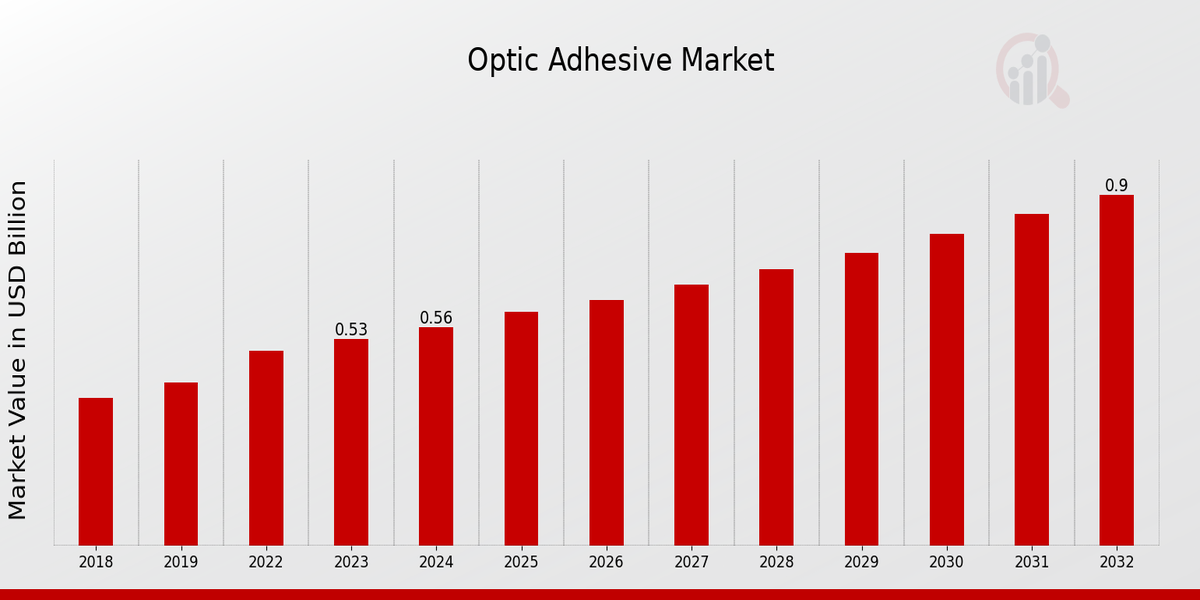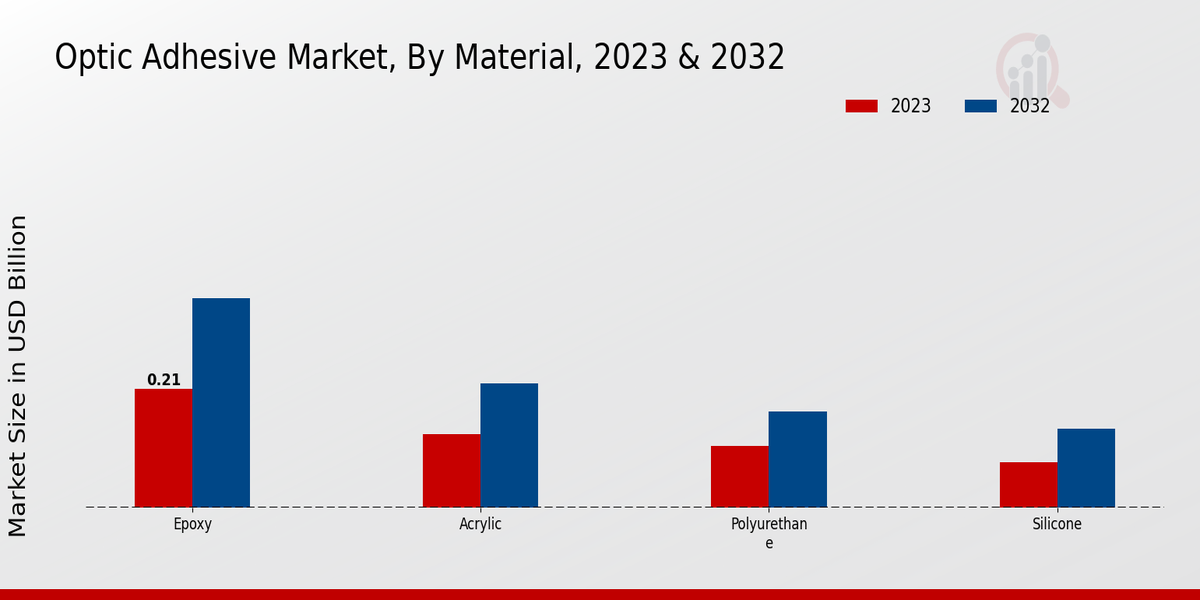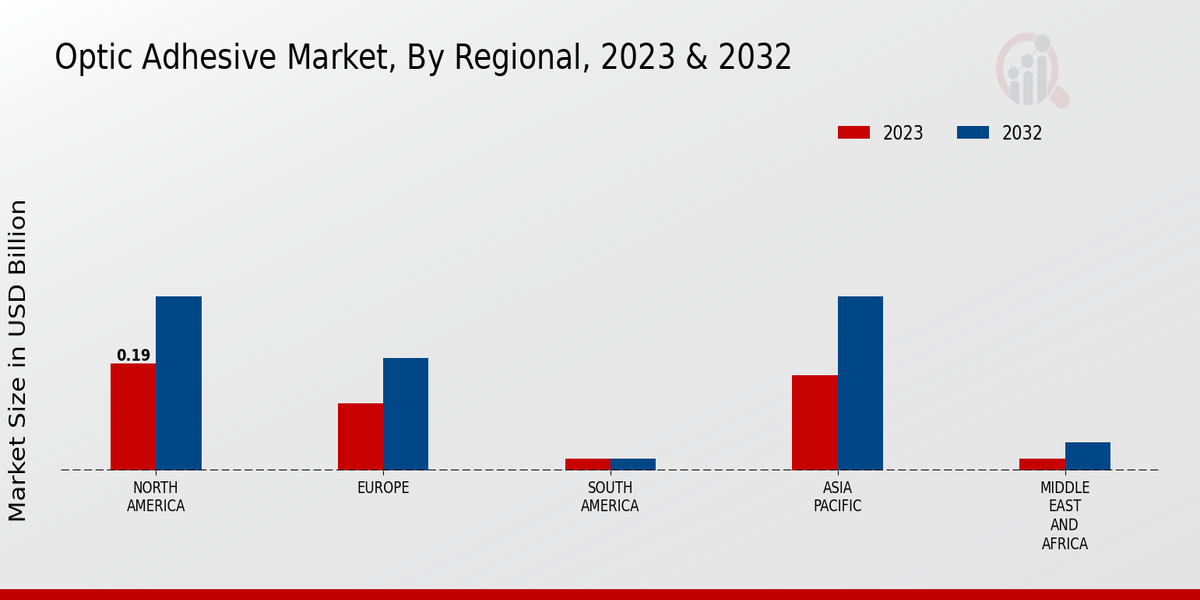Optic Adhesive Market Overview
The Optic Adhesive Market Size was estimated at 0.60 (USD Billion) in 2024.The Optic Adhesive Market Industry is expected to grow from 0.63 (USD Billion) in 2025 to 1.07 (USD Billion) by 2034. The Optic Adhesive Market CAGR (growth rate) is expected to be around 6.0% during the forecast period (2025 - 2034).
Key Optic Adhesive Market Trends Highlighted
Key optical adhesive market trends include the growing adoption of lightweight and flexible electronics, the increasing use of optical adhesives in the assembly of optical fibers and waveguides for data transmission, and the emergence of new applications in the automotive and aerospace industries.
Furthermore, the increasing availability of high-performance and cost-effective optical adhesives is driving the market growth.
Opportunities for market expansion lie in the development of adhesives with improved optical clarity, thermal stability, and mechanical strength.
In recent times, advancements in adhesive technology, such as the development of UV-curable and thermal-curable optical adhesives, have further enhanced the performance and efficiency of optical adhesives. With the increasing demand for advanced optical devices and the growing adoption of IoT, the market is expected to witness continued growth in the coming years.
Figure1: Optic Adhesive Market, 2018 - 2032 (USD Billion)

Source: Primary Research, Secondary Research, MRFR Database and Analyst Review
Optic Adhesive Market Drivers
Advancements in Display Technology
The rapid evolution of display technologies, specifically in the electronics industry, is one of the key growth drivers of the Optic Adhesive Market Industry. The burgeoning need for high-resolution, flexible, and curved displays in modern smartphones, tablets, laptops, and television systems is propelling the demand for advanced optic adhesives specially formulated to meet the specific demands of applications. Optic adhesives act as a vital material in securing optical components such as lenses, prisms, and touchscreens to the display panels, ensuring optical purity, long-lasting solution, and product durability.In addition, the demand is further augmented by the increasing adoption of OLED, micro-LED, and quantum dot displays, which necessitates an adhesive material capable of withstanding the unique challenges presented by individual degrees in such technologies.
Miniaturization and Portability of Electronic Devices
The miniaturization and portability of electronic devices, in particular in the consumer electronics sector, is another key factor that determines the dynamic development of the Optic Adhesive Market Industry. With the increased demand for small and light smartphones, tablets and other portable devices of similar kind, the optic adhesives are forced to become smaller and more space-efficient. At the same time, these adhesives still need to ensure strong bonding strength, optical clarity and protection from adverse environmental impacts.The growth of the popularity of foldable and rollable displays also increases the demand for flexible and mechanically durable adhesives.
Growth in Automotive and Aerospace Industries
Automotive and aerospace industries have seen considerable growth, which results in the uplift of the demand for optic adhesives. In the automotive industry, optic adhesives are used for various applications, such as bonding optical components in vehicle lighting systems, head-up displays, and sensors. In the aerospace sector, optic adhesives are utilized for the bond of aircraft windows, navigation equipment, and communication systems. The safety and efficiency supported by lightweight materials within the sector warrant the growth of the advanced type of optic adhesives.
Optic Adhesive Market Segment Insights
Optic Adhesive Market Material Insights
The Optic Adhesive Market is segmented into several categories based on material, application, and end-use industry. Among these segments, the material segment plays a crucial role in determining the overall market growth and dynamics. The four major material types used in the production of optic adhesives are epoxy, acrylic, polyurethane, and silicone. Each material type possesses unique properties that cater to specific application requirements. Epoxy-based optic adhesives are widely used in high-performance applications due to their exceptional strength, durability, and resistance to harsh environmental conditions.They offer excellent adhesion to a variety of substrates, including glass, metal, and ceramics, making them suitable for demanding applications such as fiber optic connectors, optoelectronics, and medical devices. The Optic Adhesive Market revenue for epoxy-based adhesives is projected to reach USD 0.36 billion by 2023, exhibiting a steady growth rate. Acrylic-based optic adhesives are known for their flexibility, transparency, and ease of application. They provide reliable bonding in applications where stress absorption and impact resistance are critical.Acrylic adhesives are commonly used in consumer electronics, automotive lighting, and display technologies. The Optic Adhesive Market data suggests that the demand for acrylic-based adhesives is expected to grow at a significant pace, reaching USD 0.22 billion by 2023. Polyurethane-based optic adhesives offer a combination of strength, flexibility, and moisture resistance. They are often used in applications where durability and resistance to environmental factors are paramount. Polyurethane adhesives find applications in solar panels, aerospace components, and marine equipment.The Optic Adhesive Market segmentation shows that the polyurethane segment is anticipated to reach USD 0.18 billion by 2023, driven by the growing demand for lightweight and durable materials. Silicone-based optic adhesives are known for their high-temperature resistance, flexibility, and biocompatibility. They are commonly used in medical devices, automotive electronics, and high-power LED applications. The Optic Adhesive Market statistics indicate that the silicone segment is expected to grow at a steady pace, reaching USD 0.14 billion by 2023.The choice of material for optic adhesives depends on various factors such as the required strength, flexibility, durability, and environmental resistance. The Optic Adhesive Market industry is witnessing increasing demand for high-performance and specialty adhesives, driven by the advancements in electronics, medical devices, and automotive technologies.
Figure2: Optic Adhesive Market, By Material, 2023 & 2032 (USD billion)

Source: Primary Research, Secondary Research, MRFR Database and Analyst Review
Optic Adhesive Market Application Insights
Application-based segmentation by the Optic Adhesive Market includes Display, Optical Fiber, Imaging and Sensor. In 2023, the Display segment held the highest market share and will maintain its dominance for the entire forecast period. The growth of this segment is attributed to the increased adoption of the technology in end-use industries such as consumer electronics, automotive and healthcare. The Optical Fiber segment is projected to grow significantly owing to the increasing deployment of fiber optic networks for high-speed data transfer.The Imaging segment is expected to grow owing to the increased usage of optical adhesives in medical imaging, machine vision and photography. The demand for sensors in applications like automotive, industrial and healthcare is expected to grow, and therefore, the Sensor segment will witness significant growth.
Optic Adhesive Market End-Use Industry Insights
The end-use industry segment plays a crucial role in shaping the dynamics of the Optic Adhesive Market. Consumer Electronics, Automotive, Telecommunications, and Medical sectors are the primary drivers of market growth. Consumer Electronics is projected to dominate the market, accounting for over 40% of the revenue in 2024. The increasing adoption of smartphones, laptops, and other electronic devices fuels this growth. Automotive and Telecommunications industries follow closely, with growing demand for advanced optical components in vehicles and telecommunication infrastructure.The Medical segment is expected to witness significant growth due to the rising demand for minimally invasive surgical procedures and the development of innovative medical devices. The use of optic adhesives in medical applications ensures precise bonding and reliable performance, contributing to the segment's expansion. Overall, the end-use industry segmentation provides insights into the diverse applications of optic adhesives and highlights the potential growth opportunities within each sector. Understanding these industry-specific trends is essential for manufacturers and suppliers to align their strategies and cater to the specific requirements of different end-use markets.
Optic Adhesive Market Cure Mechanism Insights
The Cure Mechanism segment of the Optic Adhesive Market is broadly classified into UV Curing, Thermal Curing, and Moisture Curing. UV Curing holds the largest market share, driven by its rapid curing speed and high bond strength. The Optic Adhesive Market revenue from UV Curing is projected to reach USD 0.38 billion by 2024, exhibiting a CAGR of 6.5%. Thermal Curing follows closely, with its market share attributed to its ability to cure adhesives at low temperatures. Moisture Curing is expected to witness steady growth, owing to its cost-effectiveness and suitability for applications in humid environments.These insights provide valuable data for industry stakeholders to make informed decisions and capitalize on growth opportunities.
Optic Adhesive Market Regional Insights
The regional segmentation of the Optic Adhesive Market presents distinct market dynamics and growth opportunities. North America holds a significant market share, driven by the presence of major technology hubs and a high demand for advanced optoelectronic devices. Europe follows closely, with a strong focus on research and development in the optics industry. The Asia-Pacific region is projected to witness substantial growth in the coming years, fueled by the rising demand for consumer electronics and the expansion of the manufacturing sector.South America, the Middle East, and Africa regions represent emerging markets with untapped potential, offering growth opportunities for market players. In 2023, the Optic Adhesive Market revenue is estimated to be around 0.53 USD Billion. This growth is attributed to the increasing adoption of optic adhesives in various industries, including consumer electronics, automotive, and healthcare.
Figure3: Optic Adhesive Market, By Regional, 2023 & 2032 (USD billion)

Source: Primary Research, Secondary Research, MRFR Database and Analyst Review
Optic Adhesive Market Key Players And Competitive Insights
Major players in Optic Adhesive Market are constantly striving to gain a competitive edge by investing in research and development, expanding their product portfolios, and forming strategic partnerships. Leading Optic Adhesive Market players such as Henkel, 3M, Dow, DuPont, and Dymax are focusing on developing innovative solutions that meet the evolving needs of end-users. Industry participants are also engaged in acquisitions and mergers to strengthen their market positions and expand their geographical reach. The Optic Adhesive Market industry is characterized by intense competition, with companies competing on factors such as product quality, price, and customer service. To stay ahead in the competitive landscape, companies are adopting strategies such as product differentiation, customization, and value-added services.Henkel AG & Co. KGaA is a leading supplier of adhesives, sealants, and functional coatings. The company offers a wide range of optic adhesives used in various applications, including electronics, automotive, and medical devices. Henkel has a strong focus on innovation and sustainability, and it invests heavily in research and development to create high-performance products that meet the evolving needs of its customers. The company has a presence and serves customers in over 125 countries. It is headquartered in Dsseldorf, Germany.3M Company is another major player in the Optic Adhesive Market. The company offers a diverse portfolio of optic adhesives used in a variety of industries, including electronics, transportation, and healthcare. 3M is known for its commitment to innovation and customer service. It invests heavily in research and development to create new products and improve existing ones. The company has a presence and serves customers in over 200 countries. It is headquartered in Saint Paul, Minnesota, United States.
Key Companies in the Optic Adhesive Market Include
-
Kyocera Chemical
-
Dow
-
Avery Dennison
-
Dymax
-
Elkem
-
Sika
-
ShinEtsu Chemical
-
Henkel
-
SaintGobain
-
Nitto Denko
-
Nordson
-
Morton International
-
3M
-
TESA Tape
-
H.B. Fuller
Optic Adhesive Market Industry Developments
The optic adhesive market is expected to reach USD 0.9 billion by 2032, exhibiting a CAGR of 6.04% during the forecast period (2024-2032). Growing demand for optics in various industries, such as telecommunications, consumer electronics, and automotive, is driving market growth. Additionally, the increasing use of optics in medical devices and the rising popularity of augmented and virtual reality (AR/VR) headsets are contributing to market expansion. Key industry participants include 3M, Henkel, Dow, and Dymax. Recent developments include Henkel's introduction of a new line of optical adhesives for use in the electronics industry and the acquisition of DELO by Triton, a private equity firm, in 2023. The market is expected to continue growing over the coming years due to the increasing demand for optics in various applications.
Optic Adhesive Market Segmentation Insights
Optic Adhesive Market Material Outlook
- Epoxy
- Acrylic
- Polyurethane
- Silicone
Optic Adhesive Market Application Outlook
- Display
- Optical Fiber
- Imaging
- Sensor
Optic Adhesive Market End-Use Industry Outlook
- Consumer Electronics
- Automotive
- Telecommunications
- Medical
Optic Adhesive Market Cure Mechanism Outlook
- UV Curing
- Thermal Curing
- Moisture Curing
Optic Adhesive Market Regional Outlook
- North America
- Europe
- South America
- Asia Pacific
- Middle East and Africa
| Report Attribute/Metric |
Details |
| Market Size 2024 |
0.60 (USD Billion) |
| Market Size 2025 |
0.63 (USD Billion) |
| Market Size 2034 |
1.07 (USD Billion) |
| Compound Annual Growth Rate (CAGR) |
6.0% (2025 - 2034) |
| Report Coverage |
Revenue Forecast, Competitive Landscape, Growth Factors, and Trends |
| Base Year |
2024 |
| Market Forecast Period |
2025 - 2034 |
| Historical Data |
2020 - 2024 |
| Market Forecast Units |
USD Billion |
| Key Companies Profiled |
Kyocera Chemical, Dow, Avery Dennison, Dymax, Elkem, Sika, ShinEtsu Chemical, Henkel, SaintGobain, Nitto Denko, Nordson, Morton International,3M, TESA Tape, H.B. Fuller |
| Segments Covered |
Material, Application, End-Use Industry, Cure Mechanism, Regional |
| Key Market Opportunities |
Rise in fiber optic applications Growing demand from the automotive industry Increasing use of electronic devices Emerging opportunities in the healthcare sector Advancements in technology. |
| Key Market Dynamics |
Rising demand for high-performance electronics Technological advancements in optics Growing adoption of fiber optics Increasing investments in infrastructure Development of novel adhesive formulations |
| Countries Covered |
North America, Europe, APAC, South America, MEA |
Frequently Asked Questions (FAQ) :
The Optic Adhesive Market is expected to reach a valuation of approximately USD 1.07 billion by 2034, growing with a CAGR of 6.0% from 2025 to 2034.
The Asia-Pacific region is expected to hold a significant share of the Optic Adhesive Market owing to the increasing demand for consumer electronics, automotive, and telecommunication industries.
Optic Adhesive finds applications in various industries, including consumer electronics, automotive, telecommunication, medical, and industrial.
Some of the key competitors in the Optic Adhesive Market include Henkel AG & Co. KGaA, 3M, Dymax Corporation, Delo Industrie Klebstoffe GmbH & Co. KGaA, and Panacol-Elosol GmbH.
The growth of the Optic Adhesive Market is driven by factors such as the increasing demand for high-performance adhesives in the electronics industry, the rising demand for lightweight and durable materials in the automotive sector, and the growing adoption of optical adhesives in telecommunication applications.
The Optic Adhesive Market faces challenges such as the availability of low-cost substitutes, stringent environmental regulations, and the need for advanced.
Opportunities for growth in the Optic Adhesive Market include the increasing demand for adhesives in emerging economies, the development of new and innovative adhesives, and the expansion of applications in various industries.
Key trends shaping the Optic Adhesive Market include the growing adoption of UV-curable adhesives, the development of adhesives with improved optical clarity, and the increasing demand for environmentally friendly adhesives.
The COVID-19 pandemic had a negative impact on the Optic Adhesive Market in the short term due to disruptions in supply chains and reduced demand from key end-use industries. However, the market is expected to recover and continue growing in the long term.
The optical adhesive Market is expected to grow steadily in the coming years, driven by factors such as the increasing demand for high-performance adhesives in the electronics industry and the rising adoption of optical adhesives in telecommunication applications.

















